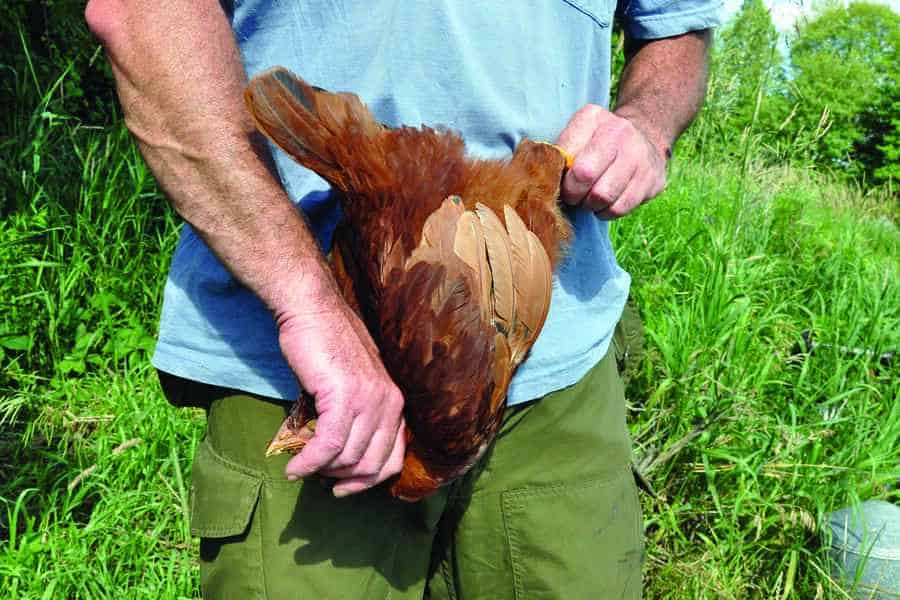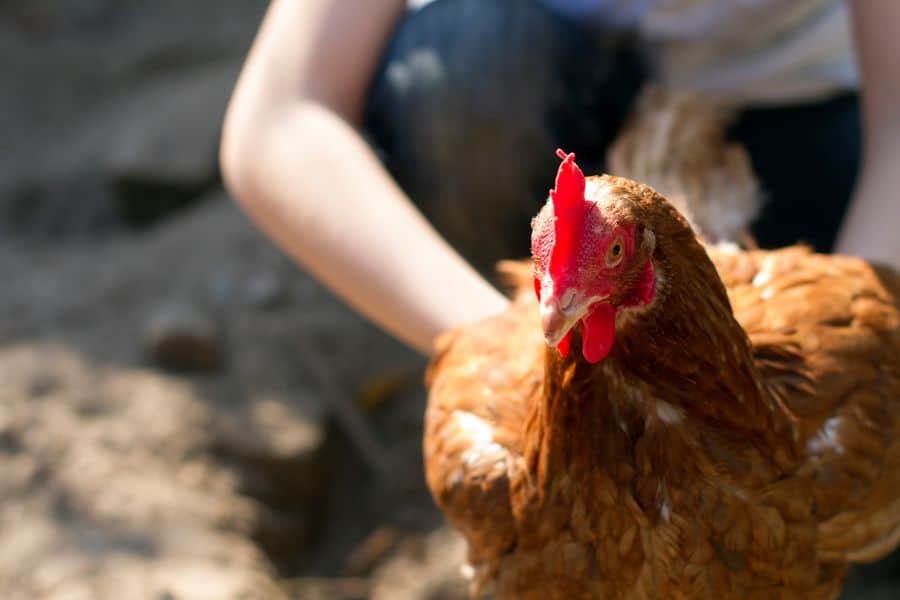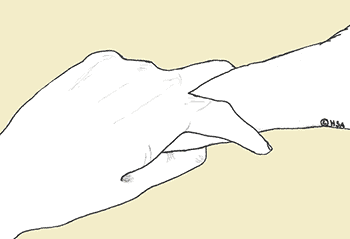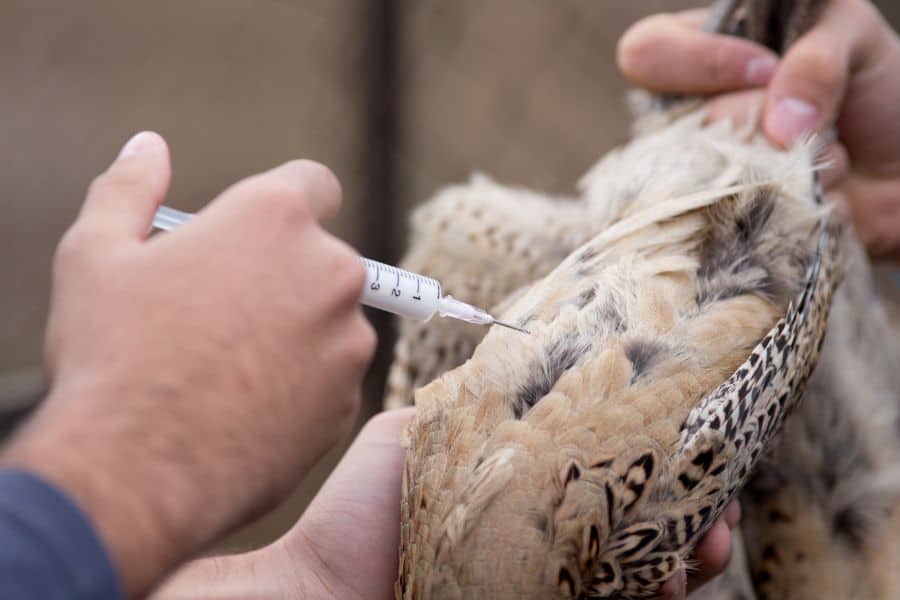Most chicken owners will have to make the decision to kill their chickens at some point. Many find this part of chicken ownership disconcerting, but it is often inevitable if not necessary.
There are many good reasons why you may need to kill your chicken. For some backyard farmers, it will even be a regular thing.
Regardless of the reason, it is important that your chickens are dispatched in a manner that is humane. In many parts of the world, it is even a legal requirement that chickens only be killed in ways that are humane.
Many people have never had to kill a chicken before and have no idea where to begin. We discuss several humane methods you can use to kill your chickens, highlighting their pros and cons. We also mention a few methods you may want to avoid going forward.
Reasons for Killing Chickens
There are several reasons why farmers or chicken owners can decide to kill their chickens. These include:
- To eat them: Human beings have been eating chicken for thousands of years so this is not a new reason.
- Culling of sick and injured birds: Sick and injured birds may endure a lot of pain and suffering before they die. When a full recovery is unlikely, ending the chicken’s suffering may be the most humane thing to do.
- Disease control: If a flock may have been exposed to a particularly contagious disease, killing them may be the most effective way of preventing the disease from spreading even further resulting in more deaths.
- For sale: Farmers who raise broilers or meat birds for commercial purposes will have to slaughter them on a regular basis to sell them.
- Stock management: If a flock of chickens is too large or if a farmer has too many roosters, killing some of the chickens will help to maintain or improve the welfare of the rest.
What Makes a Killing Method Humane?
The idea behind humane methods for killing chickens is to make the process quick and painless by stopping brain activity quickly. Humane methods of killing chickens usually result in:
- Rapid loss of consciousness
- A quick and painless death
- Minimal psychological stress to the people performing or witnessing the operation and the chicken.
Humane killing of chickens may take some practice and the skills to work with certain equipment. These methods of killing chickens also need to be reliable because some methods can still result in long and painful deaths if incorrectly executed.
What is the Most Humane Way to Euthanize Chickens?
1. Cervical Dislocation

Cervical dislocation involves disconnecting the spinal cord and the major arteries and veins supplying blood to the brain.
The disconnection needs to take place at the base of the skull for the chicken to become unconscious. This is why simply breaking the chicken’s neck at any point is not a recommended method.
Cervical Dislocation by Hand (No Tool)
Cervical dislocation by hand is one of the most used methods of humanely killing chickens. This is because when done correctly, it is usually quick and effective.
The steps involved in Cervical dislocation by hand are as follows:
- Calmly pick up the chicken or pick them up and wait for them to calm down. This will help to make the rest of the process more peaceful for you and the chicken.
- Use your non-dominant hand to firmly hold the chicken’s legs as you turn the bird, so its head points towards the ground.
- Wrap your thumb and index finger around the neck of the bird at the point where it connects to the skull. Ensure your grip isn’t tight at this point to avoid startling the chicken.
- With the tail of the chicken still facing up, tilt the head of the bird towards its back until it is at a 90-degree angle from the body. The beak should be pointing towards the ground.
- In one smooth movement, tighten the fingers around the bird’s neck and pull the neck as far from the body as it will go before sharply snapping the head back. When done correctly, this will result in the separation of the vertebrae and the severing of the spinal cord and blood vessels.
- Confirm the method has worked effectively by feeling for a gap between the skull of the chicken and the vertebrae. The chicken should not be breathing or blinking when the eye is touched.
There will be involuntary spasming and flapping after the chicken’s spine separates. At this point, the chicken is usually unconscious, and these movements are involuntary.
The advantages of cervical dislocation by hand are that when well executed:
- The chickens die quickly.
- Loss of consciousness comes about quickly resulting in limited pain.
- It requires no tools, complicated or otherwise.
- There should be no bloody mess to clean up.
The drawbacks of this method are:
- It may not be perfectly executed by an inexperienced individual.
- Is a difficult method to use with heavier chickens.
- The physical exertion makes it unsuitable for culling larger numbers of chickens.
In the UK and EU, this method can only be used on birds with a live weight of under 3kg. One person may also not perform it on more than 70 chickens in one day.
Cervical Dislocation Using a Broomstick
Cervical dislocation using a broomstick is a variation of cervical dislocation by hand.
Although many people use broomsticks, any sufficiently rigid pole will get the job done. In the video below, a steel shovel is used.
The steps for using this humane killing method on chickens are as follows:
- Hold the bird with its legs facing up and place its breast on the ground. The head should be facing away from you.
- Place the pole of the broomstick or shovel on the bird’s neck, as close to the skull as possible but not on top of it.
- Pin the chicken by stepping on the pole on either side of its head and in a quick, firm motion, pull the legs of the bird away from the head until vertebral separation occurs.
- As before, confirm with your hand that there is a gap between the vertebrae and the skull.
Please note that the video below shows the actual process of killing the chicken and may be disconcerting for some viewers. Please do not view it if you feel you may be negatively affected by the content.
The advantages of this method are that it can be used more effectively on larger/heavier birds compared to the use of hands only. It may also be easier for some people to execute.
One key downside of this method is that if you yank too hard, the head may completely separate from the neck of the chicken. This doesn’t make the process more painful, but it will create a mess.
Another downside is that pinning the chicken’s head down using the broomstick or shovel can be stressful if they’re kept in this position for too long.
2. Decapitation
Decapitation is the complete severing of the chicken’s head from its neck. Decapitation cuts off the flow of fluids that support the brain while damaging the central nervous system of the chicken.
If correctly executed, decapitation should quickly result in unconsciousness and death will quickly follow. Effective methods of decapitating chickens include:
- Having someone lay the chicken down with its neck extended while another person delivers a quick clean cut with an axe just below the skull.
- Using a cutting cone to hold the chicken with its head facing down, firmly extending and holding the neck before quickly cutting off the head with a sharp knife.
- Using a suitably large and sharp pair of scissors or shears with overlapping blades to cut off the neck.
When decapitating a chicken, care must be taken to cut and not to crush the neck. This is why the tool used for cutting must be very well sharpened before the procedure.
It is also considered more humane to stun the chicken before decapitation. Larger operations usually achieve this by dipping the chickens in an electrified water bath.
The drawbacks of decapitating chickens are:
- If the chicken was ill, this method creates a biosecurity problem since blood will be sprayed on the ground.
- The person performing the procedure will need protective equipment like chainmail gloves due to the sharpness of the blade.
Decapitation is an effective and humane method of killing chickens when done correctly. Keep in mind that it might have a significant ‘shock factor’ on those who have never performed or witnessed it before.
3. Use of Captive Bolt
Captive bolts render chickens unconscious by concussing the skull. If the tool is positioned correctly and the blow is powerful enough, the bird should become unconscious immediately.
Captive bolts can be penetrating or non-penetrating. Penetrating captive bolts penetrate the skull of the bird causing deeper damage to the brain, but the non-penetrating captive bolt is also effective.
Manufacturers of these devices will provide instructions on how to use them, but they’ll typically involve:
- Securing the body of the bird and laying its chin down on an immovable surface.
- Placing the captive bolt on the skull of the chicken just behind the comb.
- Deploying the device once or twice.
When correctly used, captive bolts are very effective at delivering a quick and painless death to chickens. The drawbacks are the cost of buying the device and the time and money needed to maintain and operate it.
4. Gassing the Chickens
Using a gas system to kill chickens has become widespread in recent years. Carbon dioxide is commonly used in such systems, but nitrogen and argon are other available options.
When exposed to carbon dioxide, chickens will quickly lose consciousness. In a space with a 50% concentration of carbon dioxide, adult chickens will die fairly quickly.
The advantage of this method is that humane euthanasia is achieved without the need for physical contact with the chicken. It can also be used to quickly euthanize many chickens or chicks.
One drawback of using this method is the initial cost of buying such systems or the time and expertise needed to create your own.
Another issue is operator safety especially when using a DIY system. Prolonged exposure to high concentrations of carbon dioxide can cause health complications for the operator.
5. Injection (For Trained Persons Only)
This last method is best performed by a trained individual such as a veterinarian. It involves the use of drugs that are injected into the bird to induce unconsciousness and death.
The birds may need to be sedated before the euthanizing drug is administered.
To be effective, these drugs must be administered in certain concentrations. This is the type of method a veterinarian may use if you take a pet chicken to them that needs to be euthanized.
Questionable Killing Methods
Over the years, farmers have used many different methods in the hopes of delivering a quick and painless death. As common as some of these methods are, there have been questions raised as to whether they are as humane as previously thought.
Such questionable methods include:
- Bleeding out the chicken by only cutting its major blood vessels
- Use of blunt force trauma e.g., using a club or metal pipe
- Overdose of anesthetic agent
Bleeding out chickens is very common but doing this without first stunning the chicken is not humane. This is because the chicken will be conscious until the lack of oxygen affects the brain.
The use of blunt force trauma can be effective, but it can also be an imprecise method. If the strike is not on target or hard enough the bird may be subjected to a great deal of pain or a person may be injured.
Administering a very high dose of an anesthetic agent such as ether may work. However, just as with the injection, it requires a trained person to get the agent and dosage right. Some anesthetics have such a large safety margin that they may not be effective at killing a chicken.
Can Benadryl Be Used to Humanely Kill a Chicken?
It has been suggested that Benadryl can be used to humanely euthanize chickens. Benadryl is an antihistamine that can be bought over the counter.
Unfortunately, there is no conclusive evidence that this method is effective or reliable. While there are those who recommend using this method, others have stated that it did not have the intended effect.
In the humane killing of animals, it is important that any method used be consistently effective.
Delivering a Quick and Painless End
There are many valid reasons for killing a chicken, but regardless of the reason, the method used should always be humane. A method can only be considered humane if it is quick and causes little to no pain to the chicken.
There are different humane ways of euthanizing a chicken including those that require no tools and those that require simple tools. There are methods that require more complicated and expensive tools and are perhaps better suited for larger chicken production systems.
Backyard farmers have been killing chickens for generations and many use methods they believe are humane. Unfortunately, recent developments have shown that not every method that seems humane is effective at delivering a quick and painless death.
Chickens do so much for us. It’s only right that their final moments be as peaceful as possible.



